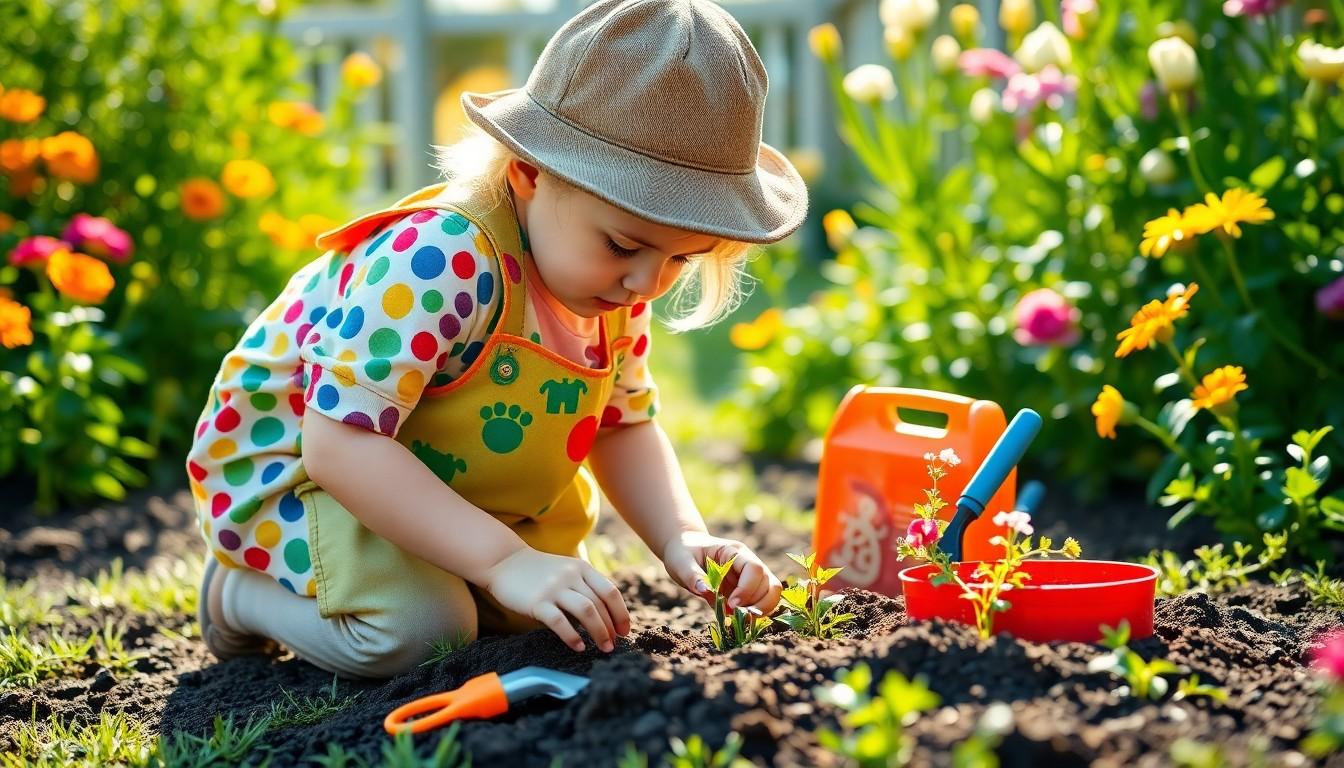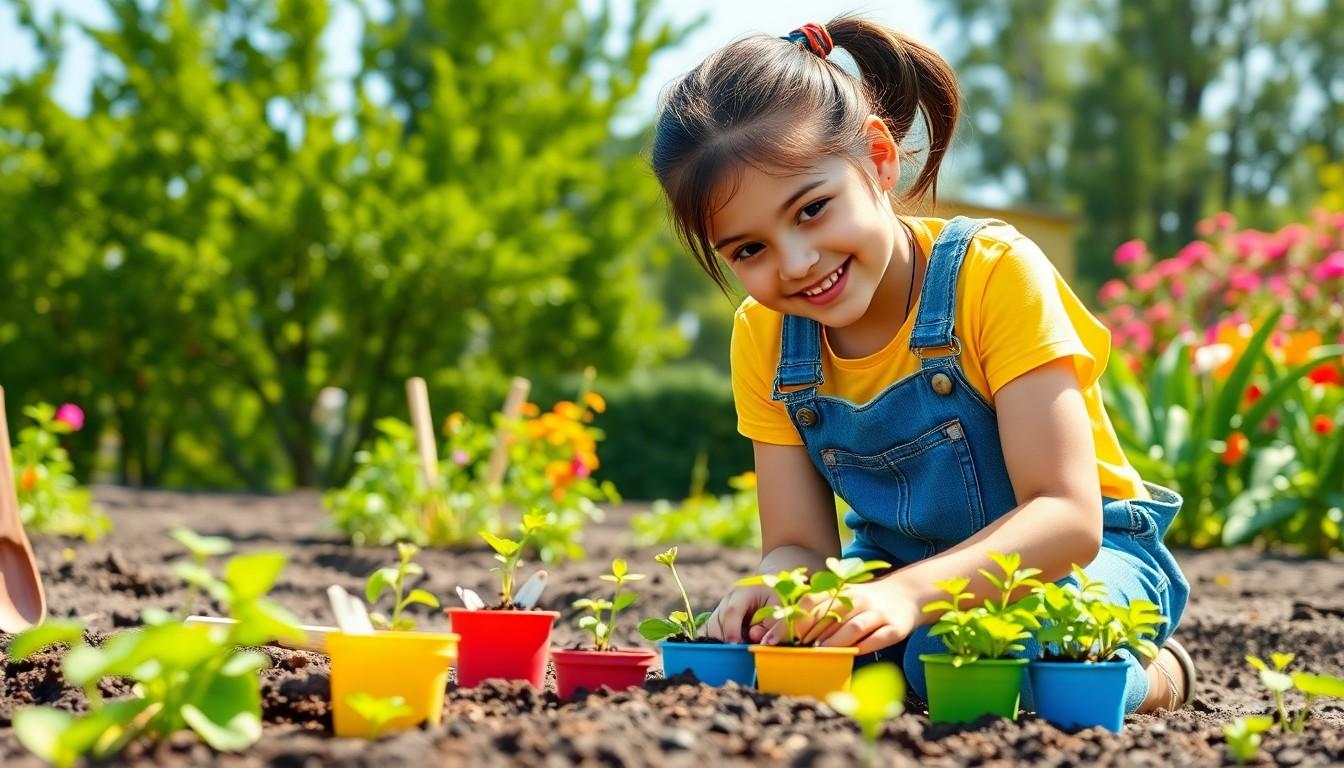Imagine a world where kids trade screen time for soil time, where tiny hands dig in the dirt instead of tapping on tablets. A kids gardening kit is the perfect gateway to this green paradise, transforming your little ones into mini horticulturists. Not only does it spark their creativity, but it also teaches them valuable lessons about nature, responsibility, and the joy of watching something grow.
Overview Of Kids Gardening Kits
Kids gardening kits provide an engaging way for children to explore the world of nature. These kits typically contain essential tools, seeds, pots, and instruction manuals designed specifically for young gardeners. A basic kit often includes items like trowels, hand rakes, gloves, and watering cans, allowing children to get hands-on experience.
Gardening kits help in developing various skills. They enhance fine motor skills as children learn to dig, plant, and care for their plants. Problem-solving abilities improve when kids encounter challenges, like pests or uneven soil conditions, and figure out solutions.
Exposure to gardening fosters a sense of responsibility. Children learn to care for living organisms, understanding the importance of regular watering and sunlight. Such experiences translate into valuable lessons about nurturing and patience.
Interest in gardening can spark creativity. Kids may design their own garden layouts or choose unique plants to grow. This imaginative aspect encourages self-expression and experimentation, making gardening a fun and enriching activity.
Educational components often accompany these kits. Many include informational booklets or guides about plant life cycles, ecosystems, and environmental stewardship. This knowledge complements practical skills and deepens children’s understanding of nature.
Kids gardening kits come in various themes and sizes. Options cater to age ranges from toddlers to older children, with more advanced kits featuring hydroponics, vertical gardening, or terrariums. Flexibility in design ensures that every child finds a suitable kit for their interests and abilities.
Benefits Of Gardening For Kids

Gardening offers children a multitude of benefits, enhancing their development in various ways.
Educational Advantages
Hands-on gardening experiences stimulate curiosity about nature. Kids learn fundamental concepts like seed germination and plant growth through interactive activities. Exposure to different plant species expands their vocabulary. Engaging with gardening kits also introduces basic math skills, such as measuring and counting seeds. Children grasp environmental awareness, understanding eco-friendly practices, and the importance of biodiversity. These educational elements contribute to a well-rounded learning experience.
Physical Health Benefits
Gardening promotes physical activity in children. Activities like digging, planting, and weeding enhance their strength and coordination. Engaging in these tasks helps develop fine motor skills. Time spent outdoors also increases vitamin D exposure, which supports bone health. Fresh air and sunlight enhance mood and energy levels. Furthermore, tending to plants can lead to healthier eating habits, as children become more interested in fruits and vegetables they grow themselves.
Emotional Well-Being
Gardening nurtures emotional growth in children. The act of planting seeds fosters a sense of accomplishment and patience. Watching plants grow instills a nurturing spirit, allowing kids to connect with living things. Gardening also offers an escape from screens, reducing stress and anxiety. The creative aspects of garden design help enhance self-expression. Collaborating with family or friends during gardening projects strengthens relationships and cultivates teamwork skills.
Features To Look For In A Kids Gardening Kit
Selecting a kids gardening kit involves examining specific features that promote an engaging and safe gardening experience. Essential elements contribute to a well-rounded gardening journey.
Tools And Equipment
High-quality tools designed for small hands enhance ease of use. Look for lightweight shovels, rakes, and trowels that fit comfortably. Durable materials withstand frequent use, while ergonomically designed handles prevent strain. Consider the inclusion of gloves to protect young gardeners’ hands. A watering can with a gentle spout allows for controlled watering without spills. Kits that incorporate a kneeling pad improve comfort during planting. Each tool plays a significant role in developing a child’s gardening skills.
Plant Selection
Appropriate plant options cater to children’s varying interests. Look for kits that offer easy-to-grow seeds like sunflowers, beans, or vegetables. Fast-growing plants provide immediate gratification, encouraging further exploration. Consider themed kits focusing on flowers, herbs, or vegetables, as these expand learning opportunities. Including plants with vibrant colors or unique shapes sparks curiosity. Kits should also provide guidance on planting times and care requirements for each species. A diverse selection enhances engagement and fosters a deeper understanding of gardening.
Safety Considerations
Prioritizing safety ensures a worry-free gardening experience. Choose kits that highlight child-proof tools and materials, minimizing the risk of injury. Tools must have rounded edges and smooth surfaces, reducing potential hazards. Parents should inspect all components for non-toxic and environmentally safe materials. Wearing gloves and protective eyewear promotes safety during garden activities. Teaching children about proper tool use further instills safety awareness. Overall, a focus on safety encourages children to enjoy gardening without concern.
Top Kids Gardening Kits Reviewed
Explore some of the best kids gardening kits available today. Each option provides a unique blend of features that cater to young gardeners.
Kit A: Features And Pros
This kit includes a variety of child-friendly tools tailored for small hands. Durable materials ensure longevity, while safety features minimize injury risks. With easy-to-follow instructions, it engages kids in the gardening process. Included seeds, such as sunflowers and radishes, provide quick growth, ensuring instant satisfaction. Parents appreciate the educational booklet that explains plant life cycles. Overall, children gain hands-on experience while enhancing their knowledge of nature.
Kit B: Features And Pros
A fun design characterizes this gardening kit, appealing to children’s interests. Lightweight tools allow for easy handling, promoting independence during gardening sessions. The inclusion of biodegradable pots encourages eco-friendly practices. Seeds for easy-to-grow plants like lettuce and herbs are part of the package, making garden maintenance simple. The kit also offers online resources, enhancing learning opportunities. This option fosters creativity, as kids can arrange their plants however they like.
Kit C: Features And Pros
This kit stands out with its comprehensive gardening approach. It combines traditional tools with unique items like plant markers and a watering can. Suitable for various ages, it promotes teamwork by allowing siblings or friends to garden together. Parents value the non-toxic materials used, ensuring safety throughout the gardening experience. Seeds for a diverse range of flowers and vegetables inspire children to explore different gardening themes. The included garden journal encourages reflection on growth, enhancing educational value.
Tips For Getting Kids Started With Gardening
Creating a garden space starts with choosing the right location. Select an area with ample sunlight and accessible water sources. Engaging children in the process fosters excitement. Discuss which plants interest them and review easy-to-grow options like sunflowers or beans.
Establish a simple plan together. Encourage kids to sketch their garden layout, promoting creativity and ownership. Provide age-appropriate tools, as well-sized equipment ensures safety and encourages active participation. Incorporating fun colors and designs can make tools more appealing.
Monitoring plant growth should be an ongoing activity. Schedule regular check-ins to observe progress. This practice teaches responsibility as children learn about plant care and the importance of consistent watering. Explain the basics of soil health and composting to enhance their understanding of gardening.
Celebrate small achievements. Host mini-celebrations when plants sprout or bloom. This approach reinforces positive feelings associated with gardening and nurtures perseverance. Sharing gardening tasks allows for teamwork, thus building relationships and communication skills.
Utilizing educational resources can deepen their learning. Consider using books or online tutorials that focus on plant life cycles and ecosystems, enhancing their knowledge of nature. Community gardens often offer opportunities for group gardening projects, encouraging collaboration and social skills.
Encouraging patience is crucial. Gardening requires time and attention, teaching children about delayed gratification. With guidance, children grow more confident in their abilities as they nurture living things, creating lasting memories through their gardening journey.
Conclusion
Embracing a kids gardening kit opens up a world of possibilities for children. It transforms outdoor time into a fun and educational adventure. Through hands-on experiences, kids not only learn about nature but also develop essential life skills.
The joy of watching plants grow instills a sense of accomplishment and fosters emotional well-being. Parents and caregivers can feel confident that these kits offer safe and engaging ways to nurture creativity and responsibility.
By choosing the right gardening kit, children can cultivate a lifelong love for gardening and the environment. This journey into gardening not only enriches their lives but also strengthens their connection to the natural world.

